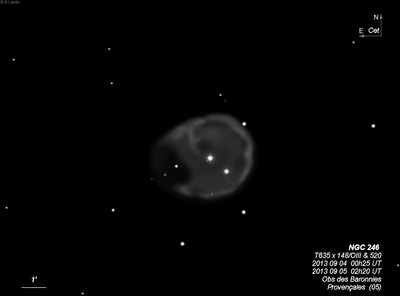
16x80 (8/24/84): faintly visible in finder.
80mm finder (10/13/07): visible unfiltered at 25x. Nice contrast gain using the NPB filter and the planetary also appears to increase in size.
William Herschel discovered NGC 246 = H V-25 = h56 on 27 Nov 1785 (sweep 478) and recorded "four or five pL stars forming a trapezium of 4 or 5' diameter. The enclosed space is filled up with milky nebulosity faintly terminated. The stars seem to have no connection with the nebulosity." The 1973 Revised New General Catalogue of Nonstellar Objects (RNGC) reversed the sign of the declination (+), and this typo was copied into some amateur software and digital setting circles.
Isaac Roberts described NGC 246 as a spiral nebula based on an early photograph. In 1912 Knox-Shaw reported it was not a spiral, but "like the Owl nebula", based on a photograph taken at the Helwan Observatory with the Reynolds reflector from 1909-11. Still Hardcastle later classified NGC 246 as a spiral nebula. Campbell (at Lick) and Paddock found the spectrum to be of a PN. Based on a Crossley photograph, Heber Curtis described (1918) "a somewhat irregular oval, brightest on western edge; 4'x3.5' in PA 120°. Periphery clear-cut, with a broken ring effect. Very faint, irregular matter in inner parts. The central star is bluish, and considerably brighter photographically than visually."
200/250mm - 8" (11/5/83): fairly faint, large, four stars involved. No annularity noted.
300/350mm - 13" (11/5/83): fairly bright with filter, clearly annular, sharper edges. NGC 255 lies 15' SSE.
400/500mm - 17.5" (1/8/00): at 100x, appears as a moderately bright, 3.5' irregular glow with a darker center and encompassing four stars including the 12th magnitude central star. Excellent contrast gain using an OIII filter, which sharpens up the edge of the roundish annulus and enhances the irregular surface brightness. The halo is brightest along a 270° arc running from SW to NE and is clearly weakest at the east edge of the halo. A mag 11.5 star is embedded at the NW edge of the halo 2.0' from center. The irregular central hole is much darker but faintly luminous. A mag 12 star is also superimposed southwest of the central star and a 4th star is just inside the eastern boundary. The central star forms a thin right triangle with the other two brighter stars. At 220x, the western 90° outer arc is brightest and there appears to be a knot embedded at the NE edge of the halo.
17.5" (9/19/87): fairly bright, large, 4' diameter, annular. Four stars are involved including the central star. This planetary has an irregular surface brightness with subtle structure.
600/800mm - 33" (9/16/07): gorgeous annular planetary viewed at 200x. The thin brighter rim was striking and varied in brightness and thickness around the periphery. The rim is brightest along the western or WNW edge and weakest on the east side. The interior was darker but irregular in surface brightness.
900/1200mm - 48" (10/23/14): At 488x with an NPB filter the view of the Skull Nebula was breathtaking and all the structure in a detailed photograph was visible. The thin brighter rim varied in brightness, thickness and scalloped structure along its entire length.
The rim is brightest along a 60° arc on the western side, bulging inward just north of center, creating a small darker indentation in the rim due west of the prominent central star. Moving counterclockwise around the rim, a small brighter, elongated patch is at the northwest edge, close to a mag 11.5 star just outside the planetary. The rim is relatively weak along the north side, but two brighter (detached) patches are along the northeast side. An irregular, elongated luminous patch spreads inward here. This glow is fairly prominent just northeast of center, on line with the central star and the second interior mag 12 star (southwest of center). A second luminous patch is midway from the central star to the north rim. The rim is weakest overall along a 90° arc on the eastern side, near a mag 13.5 star, which is embedded just within the planetary. Two more luminous patches are visible at the south rim, with the westernmost glow both larger and brighter.
The interior is relatively dark, though glows weakly with subtle variations, creating pockets of darkness - one is northeast of the central star - and mild enhancements. A small diaphanous glow is just south of the mag 12 star on the southwest side. More extensive milky nebulosity extends inward from the southern rim, though the most prominent interior glow is the split nebulosity mentioned earlier on the northwest side.
Notes by Steve Gottlieb